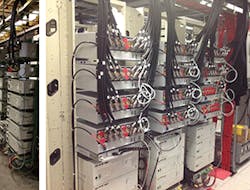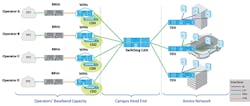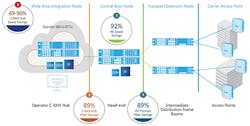Latest from 5G/6G & Fixed Wireless Access/Mobile Evolution
Challenges and Solutions for Deploying DAS and C-RAN in the Real World —
Distributed Antenna Systems (DAS) bring cellular signals indoors to buildings, arenas, airports and other venues. As the world readies for 5G mobile technology, most operators and building owners are looking at ways to upgrade existing DAS and to deploy DAS in new venues. This presents an opportunity to upgrade to digital DAS and centralized radio access network (C-RAN). Doing so can reduce complexity, decrease the space required for DAS equipment, cut costs, allow further optimization of radio resources throughout the network, and prepare the DAS for 5G.
Traditional DAS Architecture
To understand how DAS and C-RAN can enable new services in new locations, we need to take a quick look at traditional DAS architecture. A DAS consists of a headend, remote units feeding antennas, and potentially intermediate transport nodes between the headend and remote units. The big difference between a traditional DAS and a next-generation DAS is in the headend and streamlining C-RAN deployments.
Figure 1. Traditional DAS Headend
DAS deployments have traditionally been challenging because a headend requires the main distribution equipment for the DAS along with an operator’s RF signal source baseband unit plus the remote radio head. Because the remote radio head (RRH) puts out a far stronger signal than the DAS distribution headend can handle, the setup requires racks of frequency attenuators between the RRH and the headend. In addition, the setup requires monitoring equipment, a battery backup, and related power equipment to power the signal sources. (See Figure 1.)
And that’s not all. Because virtually all building owners want to support services to users of multiple mobile operators, each DAS requires RRHs and related equipment from each mobile operator. This equipment is very expensive, especially the RRH and related gear, and it takes up a lot of space. Venue owners have frequently been challenged to provide enough space for a DAS headend. In many cases, these headends have required construction of new spaces with attendant power and air conditioning equipment.
Moreover, each DAS headend must have its own signal source, so there must be an RRH in each headend location. In a university, corporate or hospital campus, for example, each building would have its own headend with RRH equipment.
InvisiLight® Solution for Deploying Fiber
April 2, 2022Go to Market Faster. Speed up Network Deployment
April 2, 2022Episode 10: Fiber Optic Closure Specs Explained…
April 1, 2022Food for Thought from Our 2022 ICT Visionaries
April 1, 2022C-RAN Architecture
C-RAN and DAS are related to each other because DAS deployments have historically been challenging in terms of cost, space, and the need to have all the signal sources from the different operators located in the equipment room of the building.
Initial C-RAN architecture moved the RF signal sources (RRHs and BBUs) from the DAS headend into a central office for centralized RAN, which is also known as base station hotels (BSH). This move significantly reduces the need for space, power, and air conditioning, at the building.
However, this approach only shifts the equipment outside the building to another location, and doesn’t address actual cost reduction.
To fully leverage C-RAN architecture, the DAS should be digital, transmitting digital rather than analog signals to the remote units. This is because a digital DAS can interface directly with the mobile operator’s BBU through Common Public Radio Interface (CPRI) rather than requiring a radio. With the CPRI interface, the operator and building owner can eliminate the need for a remote radio head to feed the DAS headend, and can instead run fiber directly from the headend to the mobile operator’s BBU located either in a central office or in the cloud.
Moving to such digital C-RAN architecture allows buildings to eliminate radio equipment on-site and enables operators to use BBUs located at near-by macro sites/central offices to feed the DAS.
In addition to eliminating space for radios, building owners can reduce the space needed for a headend by up to 90%. (See Figure 2.)
Figure 2. C-RAN Architecture
Benefits of C-RAN and Digital DAS
Digital DAS enables operators to deploy a centralized headend that serves multiple buildings, or even to tap capacity from the operator’s existing C-RAN hubs. The digital DAS routes baseband capacity to a distribution point within the served building or campus and allocates baseband capacity where it is needed while reducing the amount of on-site headend equipment and the amount of fiber needed for signal transport. In typical deployments, the space savings are up to 90% and 92% at operators BBU/BTS locations and headend at the building, respectively. Additionally, a fiber saving of up to 89% is achievable. (See Figure 3.)
Figure 3. Digital DAS Space and Fiber Savings
All-digital architecture enables capabilities that analog DAS simply cannot. Capacity
re-allocation, soft re-sectorization, system setup, and diagnostics, are all software functions in a
digital DAS, capable of being changed with a few clicks of a mouse.
Capacity reallocation allows users to move DAS capacity from one antenna or set of antennas to another. This makes it easy to support heavy-use areas like lobbies, meeting rooms, or cafeterias, without having to over-provision antennas in any given area.
Digital DAS also transports Gigabit Ethernet backhaul to each remote antenna, which can be used for separate Wi-Fi networks, IP security systems, or to support a small cell overlay needed for future network expansion.
Resource-sharing is another benefit. When the operator has to dedicate a radio resource to a venue or building, it removes the advantage of resource-sharing. A C-RAN allows operators to share baseband resources among multiple buildings.
5G readiness is another benefit. 5G architecture leverages C-RAN architecture, so by deploying a digital DAS with a direct fiber interface to the mobile operator BBU, the DAS is 5G-ready. Moreover, 5G will require many more DAS deployments than we have now because it will use higher frequencies that attenuate more quickly. Today’s 4G signals can sometimes penetrate buildings, but 5G frequencies will be much more limited in their ability to do so, necessitating indoor solutions. Digital DAS and C-RAN address this need.
Like this Article?
Subscribe to ISE magazine and start receiving your FREE monthly copy today!
Finally, by reducing the space and cost requirements for DAS, digital DAS and C-RAN make it possible to deploy DAS in far more locations than were previously tenable. A great many enterprises and small venues have historically shied away from DAS due to the cost, and now these can also deliver strong and consistent cellular service to their employees and visitors.
5G services are coming quickly, and mobile operators and building owners know they’ll need DAS in many buildings in order to distribute strong 5G signals. By moving to digital DAS and C-RAN architecture, it’s possible to deploy more DAS in more locations in a timely, space-efficient, and cost-effective manner.












